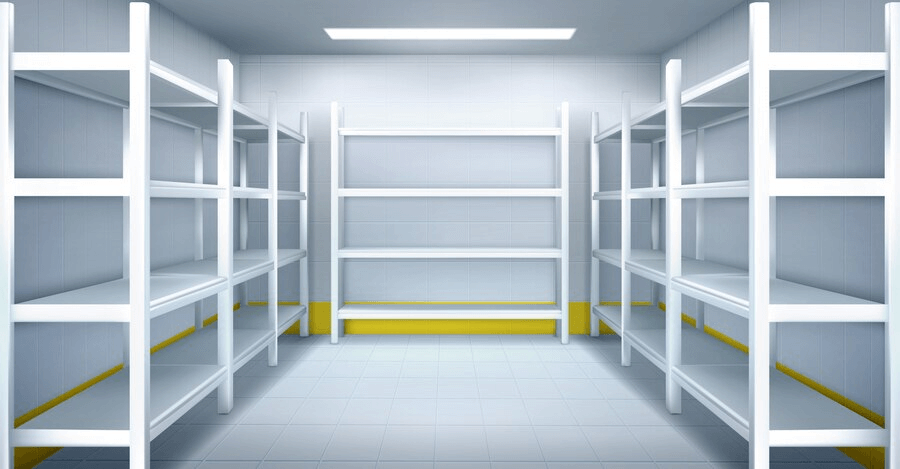
How To Avoid An Overflowing Warehouse?
November 23, 2023
Essential Pallet Rack Accessories Every Warehouse Needs for Optimization
December 29, 2023beginners guide to rivet shelving
Efficient storage solutions are crucial elements in today’s fast-paced world. Not surprisingly, rivet shelving solutions are emerging as a versatile, cost-effective storage option. Warehouse owners aiming to declutter their space, can use this storage solution to create an organized and productive environment.
If you’re interested in learning more about them, this beginner’s guide to rivet shelving is for you. We’ll explore the benefits, types, and installation process of rivet shelving so you can also make use of this efficient storage option.
What is Rivet Shelving?
Rivet shelving, also known as boltless shelving, is a very commonly used storage system. The simple yet robust design consists of vertical posts, horizontal beams, and sturdy shelves. As the name suggests, the rack and shelving components are held together with rivets.
Since the structure does not utilize nuts and bolts, this shelving solution is quick and straightforward to assemble, making it a great choice for beginners and DIY enthusiasts.
Before delving into the benefits of rivet shelving, let’s take a moment to understand the basic components:
Vertical Supports
Vertical supports create the upright framework of the shelving unit. Made of heavy-duty steel, they offer stability and durability to the structure. The vertical supports contain teardrop-shaped slots at equal intervals, allowing shelves to be easily adjusted.
Horizontal Beams
Horizontal beams connect to the vertical posts to form the shelves. They’re made of sturdy steel, helping to support the load of the stored goods.
Rivets
Rivets are the connectors that secure the horizontal beams to the vertical supports. They slide into the teardrop-shaped slots and lock the shelves into place, enhancing the stability and integrity of the shelving system.
Decking
Decking is the surface of the shelf on which goods are stored. Rivet shelving systems provide numerous decking options depending on storage requirements, such as plain metal panels, particleboard, wire decking, etc.
Benefits of Rivet Shelving
Let’s take a deeper look into how rivet shelving can be a useful option for warehouse owners.
1. Versatile Storage Solution
Rivet shelving is a highly versatile storage solution suitable for various environments, such as homes, garages, offices, retail shops, warehouses, etc. It’s a flexible and scalable option, suitable for storing various items, from household goods to heavy industrial equipment.
2. Adjustable Design
Rivet shelving systems are highly adjustable. The rivet rack steel shelving can be moved up or down to adapt to varying item sizes.
3. Optimizes Existing Space
Rivet shelving helps maximize storage capacity by optimizing the available space. The vertical posts and horizontal beams create an open structure that enables warehouse owners to store more goods. Moreover, the shelf heights and configurations can be customized so the shelving units can accommodate more items of various sizes.
4. Cost-Effective Shelving Option
Compared to other storage solutions, rivet shelving is a more affordable option. So, it’s the ideal solution for any business that is budget-conscious.
5. Better Access to Goods
The open design offers easy access to items from all sides, making it a great inventory shelving solution. Employees can load and unload goods more efficiently in this high-density storage form.
6. Easy to Assemble
The simple ‘boltless’ assembly means the rivet rack steel shelving can be put together quickly without special tools and equipment. This minimizes the cost and time of professionally installing rivet shelving.
7. Low Maintenance
Rivet industrial shelving doesn’t require much maintenance. However, you should check them regularly for rust or damage. Compromised components can be replaced cost-effectively.
8. Sturdy Structure
Despite its simple design, rivet shelving is well-known for its durability and strength. These storage units are typically made from metal structures, offering storage solutions that are reliable, secure, and safe.
Types of Rivet Shelving
Single Rivet Shelving
Single rivet shelving has a single rivet connection on each beam. This facilitates a quick and easy assembly process. Single rivet shelving options are ideal for lightweight loads, such as those found in residential and office settings.
Double Rivet Shelving
Double rivet shelving solutions have additional rivets on both ends of each beam. This increases the stability and weight-bearing capacity of the shelves. Double rivet shelving is commonly used in industrial settings where heavy items need to be stored securely.
Open Rivet Shelving
As the name suggests, these rivet shelves have open sides and backs. So, this rivet shelving offers easy accessibility and visibility to stored items. They are suitable for places that require quick retrieval, such as retail spaces, warehouses, garages, etc.
Closed Rivet Shelving
Unlike open rivet shelving, closed rivet shelving is designed to provide additional protection to stored goods. The sides and backs of this storage solution are enclosed, making it an ideal option for manufacturing facilities and workshops.
Construction Material
Several types of material can be used to construct rivet shelving. However, steel and particle board shelving are the most commonly used materials. The material you choose can influence its strength and durability. For example, solid metal shelves offer a robust, sturdy storage solution that is quite resistant to corrosion and harsh industrial environments. On the other hand, particle board rivet shelving is a cost-effective solution for lighter storage requirements.
Installation Guide to Rivet Shelving
Select a Suitable Location
Pick a location for the shelving unit that aligns with your storage needs and offers easy access to your inventory. Ensure the floor is levelled so that the structure remains stable.
Evaluate Your Storage Needs
There are several types of rivet shelving options. Determine the type that matches your storage requirements and budget. Select the right one depending on the facility’s storage capacity, the weight and dimensions of the goods you are storing, the load capacity of rivet shelving, etc.
Accurately Measure Your Space
Before you place an order for your rivet storage system, measure the space where you plan to install the structure. Ensure the space accommodates the height, width, and depth of the shelving units.
Assemble the Structure
Many rivet shelving systems can be assembled without special tools, so a rubber mallet is often all you need to secure the rivet connections. However, follow the manufacturer’s instructions since brands may have different assembly instructions.
Always start assembling the shelving unit from the bottom up. Begin connecting the vertical posts to the horizontal beams, securing them in place. This creates the framework for the shelves. Place the selected decking on top of the horizontal beams so you can store your merchandise. Use a level to ensure the rivet shelving unit is even and stable. Repeat this process until all the shelves have been assembled.
Safety Considerations When Installing Rivet Shelving
Make Sure to Secure the Unit
Securing the rivet shelving structure to the floor and wall with anchors or brackets is crucial for the safety of your employees and your inventory. The anchors and brackets keep the structure in its place, preventing it from tipping over.
Follow Weight Limitations
Read the manufacturer’s guidelines about the weight capacity of the rack and shelves. Adhere to these recommended limits to prevent overloading the shelves. Also, be mindful of weight distribution when loading merchandise onto the shelves. Distribute heavy items evenly across the shelves to maintain their balance. Placing too much weight on the shelves or in one spot can compromise the structural integrity of the unit, creating a safety risk for your employees and facility.
Inspect the Shelves Regularly
Check your rivet shelving for any signs of damage or wear and tear that could compromise the integrity of the system. Tighten any loose rivets and replace damaged or rusted components promptly to prevent accidents and extend the lifespan of your storage solution.
Final Thoughts
After reading this guide to rivet shelving, you’ve probably learned a lot about this efficient and versatile storage solution. But before investing in one for your facility, make sure to find a reputable company like Midwest Distribution.
As your reliable companion in the quest for efficient storage, we can help create a custom storage solution that optimizes your space, making it more organized and efficient. For more information about your rivet shelving options, speak to one of our representatives today.

